This bird is native to North America. It is not a traditional bird in European or Middle Eastern falconry as it does not exist in the wild in Europe, but it has been very successfully used for falconry worldwide since North American falconry developed. The Red-Tail hunts small rodents, mice, voles, snakes, and even rabbits in the wild, but will hunt just about anything if the opportunity arises. Because of their large size, they are great birds for hunting rabbits as they can get through even deep brush and have the physical size to catch and hold rabbits. This is the staple of apprentices being one of two widely used birds; it is an under-estimated hunting companion.
The call of a Red-Tail is a sound most people have heard, whether they know it or not. It is frequently used in movies (especially Westerns) and substituted in for many other birds as the sound of a red-tail is a clear 2 - 3 second piercing call.
Plumage
The immature Red-Tail is mostly identified by the banded tail. This means that the tail of the immature bird has horizontal stripes across it, called bands. Here the bands are easy to see on this Western Red-Tail. Some birds are so dark that their bands are difficult to see. These are important for the apprentice to be able to recognize as they are the markings to look for to know that the bird you have sighted to trap is, indeed, an immature Red-Tail.
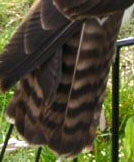 |
The striped or banded tail of an immature Red-Tail hawk. |
Most of these will fall out during the first year moult and the feathers that replace them will be the adult red feathers. Here is a bird in its first moult. It has lost 5 tail feathers and 2 adult feathers have half-way grown in. The red feathers growing in are the hallmark of an adult red-tail and the source of their name. The dark stripe across the bottom of the adult feather is called the terminal band or terminal bar, although it is not always present.
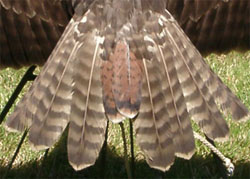
And here is the fully grown in tail of the mature Red-Tail Hawk.
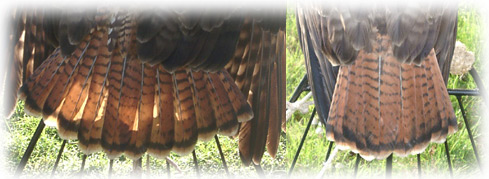
Morphology
The body form of the Red-Tail is marked by a large body, broad wings, broad (relatively short) tail. The outer four primaries are notched.
There are up to 16 subspecies (some put it at 7 with a variety of races) of Red-Tails in North America. There are different colorations, or morphs, adding variety within each subspecies. The darkest subspecies is called the Harlan's Hawk (Buteo jamaicensis harlani). The lightest subspecies is called the Krider's Hawk (Buteo jamaicensis kriderii). Some of the most common are the Eastern (Buteo jamaicensis borealis), the Western (Buteo jamaicensis calurus), Southwestern or Fuertes' (Buteo jamaicensis fuertesi), the Florida (Buteo jamaicensis umbrinus), and Grennell (Buteo jamaicensis alascensis). Most all of these birds display a dark patagial mark which is a dark patch in the "underarms". These birds can be so dark as to appear to be Harris' Hawks or even an almost black-chocolate color, and there are albino (pure white with red or pink eyes) and leucistic (pure white with blue eyes) colorations as well.
The immature birds have a slightly different shape than mature birds appearing slightly slimmer with narrower wings and tail.
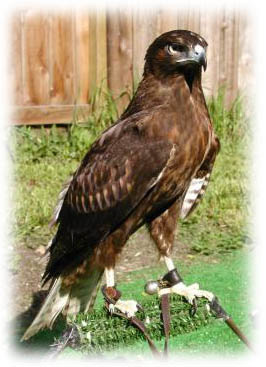 |
An adult Red-Tail so dark he could almost be mistaken for a Harris' Hawk. |
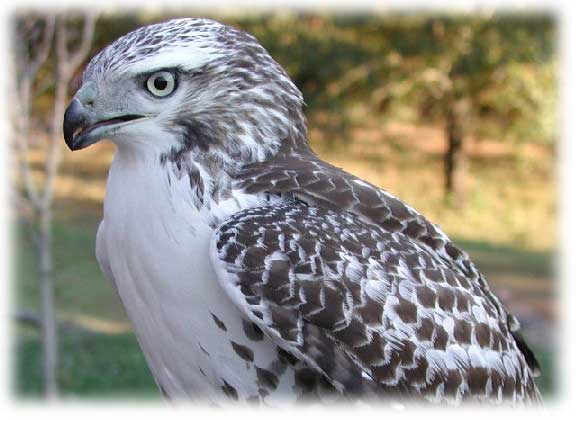 |
A passage Red-Tail, most likely a Krider's or a light morph Harlan's.
Photo courtesy of Cody Fields. |
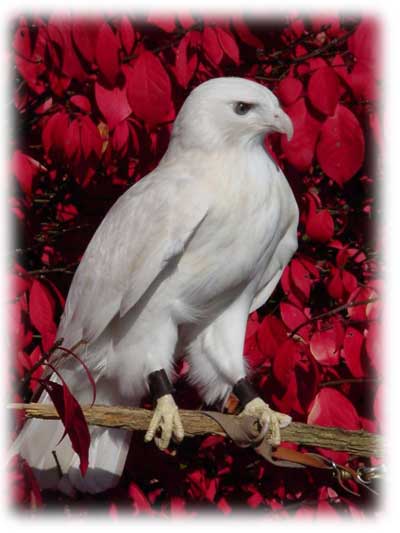 |
A leucistic Red-Tail Hawk. This bird actually has very poor vision as is common among various albino animals.
Photo courtesy of Eileen Wicker of Raptor Rehabilitation of Kentucky Inc. |
Typical quarry caught with the Red-Tail will be cottontail rabbits, jackrabbits, pheasants, ducks, and other large prey. In the wild their diet also consists of rats, mice, and sometimes chickens, although they are highly adaptable and not terribly fussy about their food so their diet often has been observed to include squirrel, shrew, skunk, lizard, and about anything else. They will sit for hours on relatively high perches hunting with a sudden dropping pounce on their prey. These birds are the equivalent of cargo planes - large with lots of momentum and power, but unable to be as maneuverable or quick as smaller birds giving their flight style a rather heavy, lumbering, or ponderous appearance. They need better perch options than Harris' Hawks when hunting requiring a perch that is physically more substantial and one that is higher to let them use gravity to their advantage. Red-Tails rely on gravity for assistance in gaining speed more than Harris' Hawks, although they can also take prey from the fist or can be taught to soar using thermals and wind to wait on. These are all good considerations when evaluating your environment for hunting and a good bird to hunt with.
They are suited for living at the edge of woods with open land and typically hunt from a high perch using gravity to get quick speed. These are the birds which perch on lamp posts over the interstate waiting for mice or road kill. As such, they can be hunted in a variety of situations from urban areas to large open fields to desert. They can be hunted from a perch, from the fist, or from a soar.
Red-Tails are masters at adapting. Although they prefer to let gravity help them gain momentum and hunt from a high perch, they are equally able to hunt from a high soar, stealth, or even stooping repeatedly.
Trivia
The term for the female Red-tail is much debated as there is no traditional term, although "hen" is generally not accepted. The male is generally called a "tiercel".
Other terms for this bird are chicken hawk, buzzard, buzzard hawk, hen hawk, mouse hawk, red hawk, redtail, and red-tailed buzzard. In some Native American cultures, this bird is a sign of good luck.
An immature Swainson's Hawk can look exactly like a Red-Tail Hawk and sometimes close examination is needed to tell the two apart.
Red-Tails start laying eggs in March and April and the incubation period is 43 days. Clutches are usually 3 eggs, out of which 2 will actually fledge. Branchers are usually seen in June.
Current population in North America is thought to be roughly 350,000. Some studies have shown that out of 100 Red-Tail Hawks hatched 73% die in the first year. Roughly 5% will live to the age of 5 years old in the wild. The average lifespan is 2 years old. There are falconers with quite old Red-Tail Hawks as their hunting partner - 28 years or 30 years is very possible for a well cared for bird in captivity. While it is possible for a wild bird to live that long, there are many dangers in the wild that make that unlikely for the vast majority of birds hatched each year.
Western Red-Tail Hawks tend to dive bomb intruders coming into the nest. Eastern Red-Tail Hawks tend to make vocal cries from a distance.
Generally an active Red-Tail needs roughly 10% of its body weight worth of food per day in moderate weather, depending on the quality and substance of it. However often in the wild these birds will hit a day or two without success. Many rehabilitators, falconers, and zoos practice a day of fasting for these birds per week to simulate the natural cycle and keep the raptor's metabolism moving.
Links
https://peregrinefund.org/explore-raptors-species/hawks/red-tailed-hawk
http://www.schmoker.org/BirdPics/RTHA.html
http://www.dyesscreek.com/miscellaneous_pages/kriders.html https://www.pbase.com/thefeather/leucistic_red_tailed_hawk